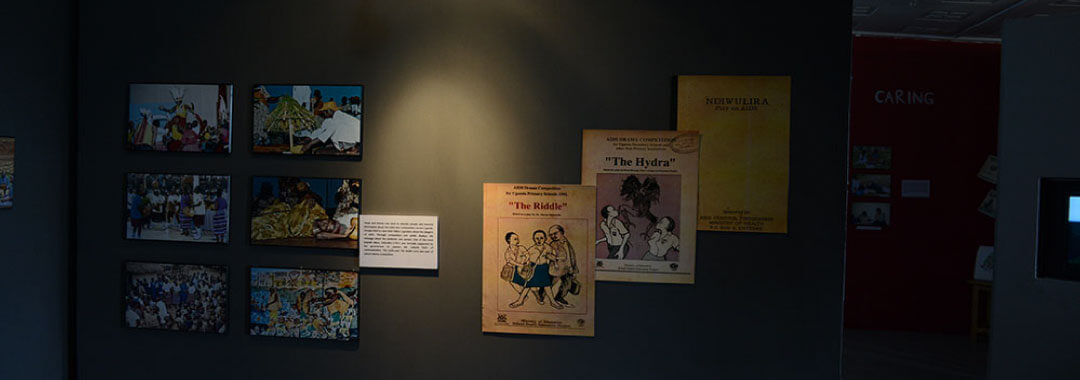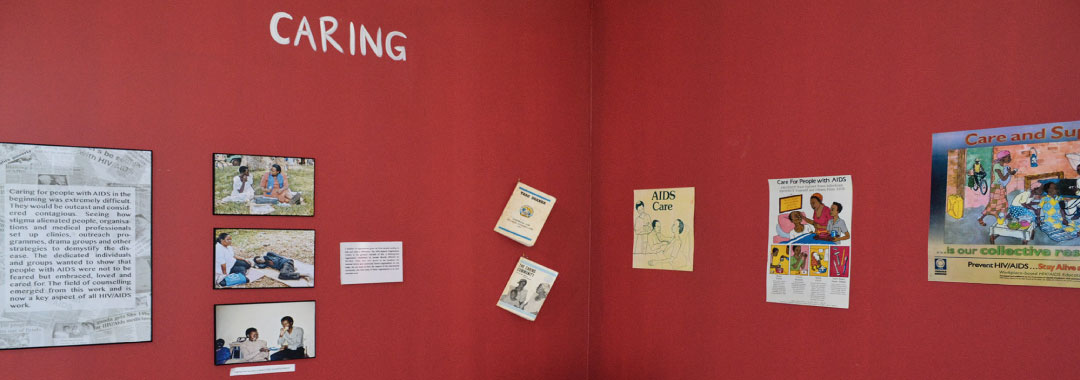
History of HIV in Uganda exhibition
Have you ever wondered about the story of HIV in Uganda? How it might be visualised in local contexts? Or what the narratives, artefacts and archives over the time of the epidemic look like?
A consortium consisting of Academy for Health Innovations Uganda at Infectious Diseases Institute (IDI), The AIDS Support Organisation(TASO) and Uganda AIDS Commission (UAC) proposed the development of a participatory exhibition initially held at the Uganda Museum. The overall objective is to establish an exhibition to document the history of HIV in Uganda through archived materials.
The exhibition showcases IEC materials from different organisations spanning from the last 30 years on the HIV/AIDS response in Uganda. These include photographs, videos, newspaper articles, and loaned artworks.
In Uganda, during the 1980’s and 1990’s behavioural change communication (BCC) campaigns were effective in reducing the spread of HIV. Many younger people may be complacent about HIV as they have not lived through the times when HIV was killing thousands of people weekly before effective treatment was available. UNAIDS have warned that complacency (in people at risk and in policymakers) about HIV that has caused a stalling in the prevention of new HIV infections in adults, and a rise in new infections in young people.

Given these issues there is still a need for innovative methods targeting these KP/PPs to further reduce HIV transmission in order to achieve global and national targets on HIV elimination. We hypothesize that through engagement with a historical exhibition about HIV will raise awareness of HIV risk factors, thereby reducing risky behaviour and unsafe sex in target populations. This project directly contributes to the first 90% of this target by encouraging people to test for HIV who have not tested before. Additionally, PLHIV who are not in care are be encouraged to access care through engaging directly with the exhibition and the PLHIV peer support guides, thus contributing to the second and third 90s.
Stakeholders including Ministry of Health, NGOs, health care workers, people living with HIV (PLHIV) were and are consulted on exhibition content and structure. Curation was and is undertaken in a participatory manner in order to make the exhibition as accessible as possible and to highlight that the urgency of these messages has not diminished.
The exhibition was officially launched on 28th November 2018 by the Embassy of Ireland and opened to the general public on 1st December, 2018. It set out to reach at least 500 people from 1st December to 31st December, 2018. However, by the end of two months, the exhibition had hosted a total of 2,202 people. The exhibition visitors include secondary school students, University students, out of school youths, most at Risk Populations (including sex workers, boda- boda riders), senior health officials, leaders of NGO’s, local and international media houses among others.

Following a successful static exhibition, Academy for Health innovations under Infectious Diseases Institute (IDI) won a grant from Wellcome Trust to take this exhibition to six different sites in Uganda, namely; Arua, Hoima, Rakai, Moroto, Wakiso and Kampala.
Objectives;
- To scale up access to the exhibition, reaching 5,000 people across the six sites through mobile exhibition
- To encourage participatory curation, through stakeholders (100), to enrich the exhibition content through contribution of additional materials and opinions.
- To promote dialogue about BCC materials with young people (age 15-25) and to provide opportunity for HIV testing for all (target: 800 individuals).
- Digital archive for HIV in Uganda and making it accessible to public and researchers.
- Permanent site at Uganda Museum and at TASO.
History of HIV in Uganda
You are either infected or affected”, said Namubiru Priscilla during one of the stakeholders’ meetings, and she couldn’t have been more right about the impact that the HIV/AIDS epidemic has had on Uganda. Priscilla is one of the many who were interviewed and consulted for this undertaking of documenting the History of HIV/AIDS in Uganda. Millions of Ugandans have been infected and millions further affected by the virus. To unshackle ourselves from the burden of such profound experiences we must first look back in time.
Through the stories and materials donated to this effort, we are able to see Uganda’s journey from the unknown to the wealth of information on the virus available today. From sensitisation campaigns, to newspapers, archives, personal artefacts, music and film, we present you with a mosaic of stories to bring us closer to a better understanding of the journey of HIV/AIDS in Uganda. Read more about History of HIV in Uganda
